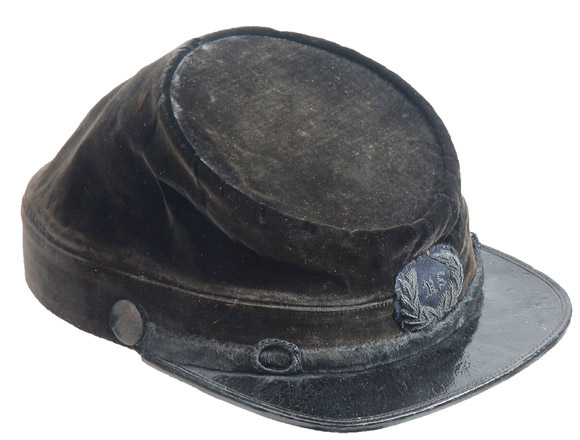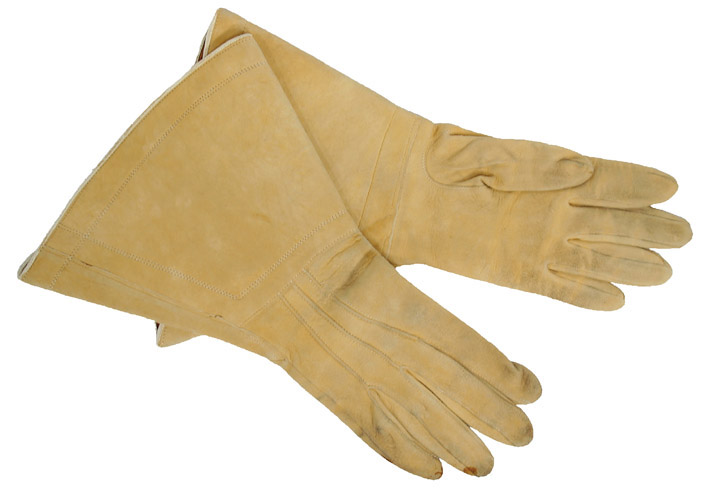
1863–1865

SOLDIERS OF THE UNITED STATES COLORED TROOPS received the same uniforms and equipment as all United States troops. Only their salaries were reduced from those received by white soldiers. Black soldiers, non-commissioned officers, and even officers were entitled to only ten dollars a month as opposed to the thirteen dollars a month paid to white privates, with an increasing pay scale according to rank in white units. It was not until March 1863 that pay for black soldiers was fully rectified.
This private of the 4th Regiment of Infantry, United States Colored Troops, is fully uniformed and accoutered for winter. His overcoat is the standard single-breasted foot pattern of sky-blue kersey with attached cape. His trousers are of the same cloth, and his 1858 pattern forage cap is the type issued to most Union soldiers. He has decorated his cap with the infantry branch insignia (horn) with company letter and regimental number—as did many other soldiers, in defiance of uniform regulations.93
His accoutrements—cartridge box and shoulder belt, waist belt with “US” plate, and cap box, haversack, canteen, and cup—are typical of all Union infantrymen. This soldier has rolled his blanket within his rubber blanket or poncho and affixed it to his unseen knapsack. He leans upon his P1853 Enfield rifle musket. This imported British weapon was the second most common shoulder arm of the Federal infantry after the United States patterns of .58-caliber rifle muskets. In all ways, other than his racial heritage, this soldier is a typical American soldier of the Civil War.94
The 4th Regiment was organized at Baltimore, Maryland, from July to September 1863. In October of that year it was moved to Fort Monroe, Virginia, and then up the peninsula to serve in the 18th Corps. Subsequently it was moved to the 25th and 10th Corps. It skirmished at Bermuda Hundred in May 1864, and then, after building Fort Converse at Bermuda Hundred, defended it. The regiment then served before Petersburg and at the mine explosion. The regiment continued in combat around Petersburg and Richmond before moving to North Carolina and the assault and capture of Fort Fisher in 1865, followed by the campaign through the Carolinas. The 4th lost 292 officers and men in the war, including 3 officers and 102 enlisted men killed in action or mortally wounded.

Smooth-side tin canteen with a gray cloth cover stenciled in white paint, which belonged to the 10th Connecticut Volunteers. In most cases canteens were not unit marked but some regiments chose to do so, particularly in the early part of the war. DON TROIANI COLLECTION

A pair of wool-cotton mix sky-blue kersey trousers worn by Edgar S. Yergason of the 22nd Connecticut Volunteers with the original striped suspenders. Yergason was a nine-month volunteer and served from 1862–63. DON TROIANI COLLECTION

A smooth-side canteen painted by an unknown member of the 9th Infantry regiment. C. PAUL LOANE COLLECTION

Blue leather chevrons worn by Sergeant Jason Lewis, Company A, 46th Massachusetts Volunteers, 1862–63. Most likely these were intended for use on an overcoat or rubberized raincoat. JAN GORDON COLLECTION

Lemuel E. Elston of Company F of the 124th New York Volunteers (the Orange Blossoms) carried this black-painted canvas knapsack and smooth-side canteen with a cotton sling. Elston mustered in as sergeant in September 1862 and was discharged for disability on January 1, 1863. PHOTOGRAPH COURTESY OF SKINNER AUCTIONEERS AND APPRAISERS, BOSTON, MASSACHUSETTS

Major general’s coat of blue wool with black velvet collar and cuff trim worn by Gouverneur K. Warren. An able commander and hero of Gettysburg and then afterward the Army 5th Corps, Warren ran afoul of Philip Sheriden, who ruined Warren’s military career. Years afterward he was exonerated and led a life as a successful engineer. The U.S staff buttons are set in threes as appropriate for this rank. WEST POINT MUSEUM, HIGHLAND FALLS, NEW YORK

Part of a myriad of privately purchased canteens available to soldiers was this foil-lined, leather specimen patented by Lazare Cantel, October 14, 1862. Worn on a leather strap and sealed on the edges with copper rivets, it might have kept water a little cooler than the issue tin item. Due to the rarity of surviving specimens, it appears not to have been universally popular. DON TROIANI COLLECTION

This coat was worn by Major General George B. McClellan, commander of the Army of the Potomac during the 1862 campaigns. It was mostly regulation except for the narrow black tape trim on the cuffs. SMITHSONIAN INSTITUTION

Major general’s frock coat of Hugh Judson Kilpatrick, a flamboyant cavalry commander during Sherman’s Atlanta campaign and march to the sea. He was a stylish dresser and notorious bon vivant; the nonregulation embroidered laydown collar on this coat is typical of his character. SMITHSONIAN INSTITUTION

Coat for a captain of the United States Army Corps of Topographical Engineers. Formed in 1838, it was thereafter composed of the cream of the West Point cadet classes. Their duties were mapping and constructing fortifications and other civil projects. In March 1863, they were merged into the Corps of Engineers and ceased to exist as a separate entity. Note the staff officer’s shoulder straps and “TE” brass buttons. MIKE BARILLA COLLECTION

Colonel of infantry, bullion-embroidered shoulder straps on a light blue velvet base. DON TROIANI COLLECTION

This impressive dark blue officer’s greatcoat was bound with a now-faded black silk tape and closed with cords and toggles. Many of these coats had a detachable cap, which if lined with red as this coat, would have presented a graceful appearance flying in the wind. Lieutenant George Bates of the 14th Illinois Volunteers wore this particular coat. MICHAEL CUNNINGHAM COLLECTION

Aregulation frock coat with infantry eagle buttons evenly spaced worn by Colonel Clarence Buel of the 169th New York Volunteers. Buel was wounded in action on April 24, 1863, at Edenton Road and discharged for disability in February 1864. After the war, Buel was an editor of the famous Battles and Leaders of the Civil War published in 1887. DON TROIANI COLLECTION

Private purchase fatigue blouse worn by Major General Clinton Bowen Fiske, who began the war as colonel of the 33rd Missouri Infantry. Very well tailored from quality blue wool, it features a black tape edge to the pockets as well as the front opening and is finished with a black velvet collar. Fiske’s wartime service was solely in Missouri and Arkansas, where he proved an able leader. MICHAEL CUNNINGHAM COLLECTION

A long officer’s sack coat made by a merchant tailor in Belleville, Illinois. Loose, easy, comfortable, and functional, coats like these with extra pockets were extremely common, and most officers in the field owned either a long or short version. DON TROIANI COLLECTION

Cap worn by Chaplain Thomas P. Hunt of the 2nd Pennsylvania Heavy Artillery. Chaplains were prescribed by army regulations in 1861 a black frock coat with black cloth-covered buttons, and Chaplain Hunt chose for himself a complementary cap, custom-made of black velvet with black cloth-covered buttons as well. Though in 1861 no cap device for chaplains was specified, in actual practice the U.S. staff wreath was occasionally worn and officially authorized by 1864. The Baker & McKenney imprint with the 63 Walker Street address is especially important, as after founder John Baker died, his wife took over the business and joined with McKenney. In December 1864, the location changed to 141 Grand Street, where it remained until the 1880s. JAMES C. FRASCA COLLECTIONS

A pair of beautiful buff leather gauntlets worn by Colonel William Stoval Tilton of the 22nd Massachusetts Volunteers. DON TROIANI COLLECTION

A fancy shirt bought by Colonel William S. Tilton of the 22nd Massachusetts Regiment while incarcerated at Libby Prison in 1862. Rather unmilitary, it is mostly made from ladies’ dress fabric, but considering the circumstances beggars could not be choosers. DON TROIANI COLLECTION

General officer’s kepi. Although typical in both style and design to others worn by high-ranking Federal officers, this kepi holds an inimitable and important place in American history. With its distinctive two-star insignia, designating rank, it was part of the uniform of Major General John F. Reynolds and was worn by him as he rode into his final battle at Gettysburg, Pennsylvania, on July 1, 1863. This important reminder of that fateful day was preserved by the Reynolds family. GETTYSBURG NATIONAL MILITARY PARK COLLECTION

Colonel William Goddard may have worn this elegant chasseur cap when he commanded the 1st Rhode Island Detached Militia at the first battle of Bull Run. Of the highest quality and fully taped, it bears an embroidered bullion wreath on the front with the letters “RI.” State designations like this on officers’ caps mostly disappeared once regiments became part of the Federal army. Goddard later served as aide-de-camp to General Burnside at the battle of Fredericksburg. U.S. ARMY CENTER OF MILITARY HISTORY

This French-style chasseur cap, more popularly known as the McClellan because the crown was inset to the sides, is the original item worn by Major General George B. McClellan, commander of the Army of the Potomac. It was made by the firm of B.H. Stinemetz in Washington, D.C. It bears the regulation staff wreath and “U.S.” on the front. SMITHSONIAN INSTITUTION, DON TROIANI PHOTO